
IBM says the cognitive era is one in which companies compete with each other by using algorithms, which are to a great deal responsible for how those companies develop, advance and succeed. Cognitive computing capabilities are emerging that resemble human learning and thinking processes: Discovery, Decision and Engagement. It’s taking data analysis as we know it to an entirely new level.
As we heard in many of the presentations at IBM BusinessConnect Helsinki 2016, digitalisation is a data-driven enabler for re-inventing and re-imagining the customer experience. That new experience can then be implemented through fresh business models and ecosystem-based collaboration. Partnerships are everything, because partners make innovation easier to achieve.
IBM BusinessConnect 2016 brought together a big crowd of about 1,500 enthusiastic professionals looking to get inspired and excited about the partnership opportunities offered by digitalisation and the Internet of Things (IoT). The program was fully packed with interesting presentations from IBM, KONE, Finnair, cyborg Neil Harbisson, and Comptel’s hybrid cloud, just to mention few. Here’s a summary.
The IBM/Comptel Telco Story
IBM and Comptel have a long-standing partnership that stretches over 10 years. Comptel is both a partner and a customer of IBM software and services. Together, we are actively helping telco operators around the world transform their OSS/BSS environments. Our strategic partnership is in the area of Digital Service Lifecycle Management (DSLM) with the IBM Architecture for Cloud-Based Networking, devising a new model for service orchestration and delivery of SDN/NFV.
Internally, Comptel deploys IBM cloud software assets in a hybrid environment for R&D, testing, training and more, both on-premises in Comptel’s own data centre and off-premises in the cloud. This hybrid workstyle offers us flexibility and agility, creating a better customer experience, whether we are using services on- or off-premises in single or multi-tenant mode.
IBM, like Comptel, believes in this hybrid cloud model. A presentation from IBM explained the global movement toward cloud, but stressed that cloud should not be viewed simply as a blanket destination: “Not every service needs to move to the cloud,” said the presenters. The key consideration for telcos is to figure out which services are better to run in a cloud environment, and then achieve seamless end-to-end orchestration across the hybrid network environment. Ultimately what matters most is being able to deliver a compelling customer and user experience irrespective of where the service resides.
Cognitive Computing in Healthcare
IBM and Tekes discussed their partnership, which resulted in the creation of the Watson Health Center of Excellence in Finland. Their aim is to improve the health of citizens, further local innovation and strengthen the Finnish healthcare business ecosystem. The partnership invites health companies to build an ecosystem on top of IBM’s Watson platform to create “the world’s most advanced data-led IoT hospitals.” Healthcare touches us all, and there’s a big need and sense of urgency around creating new innovative and disruptive health services. The ultimate vision is to establish a hospital-free model where the hospital is a base for service and care at home.
Moving People at an Urban Scale
 KONE, a Finland based company serving more than 400,000 customers worldwide, moves more than 1 billion people every day with more than 1 million elevators and escalators. They anticipate the urbanisation trend to accelerate business, as more than 200,000 people are moving into cities every day, driving the need for sustainability and smart urban living. By embracing open innovation, KONE benefits from fresh ideas from outside their own company. Through IBM Watson, KONE has made a massive volume of escalator and elevator data available to third-party startup companies to innovate. This ecosystem and collaborative approach to innovation will be essential for KONE to take its business to the next level.
KONE, a Finland based company serving more than 400,000 customers worldwide, moves more than 1 billion people every day with more than 1 million elevators and escalators. They anticipate the urbanisation trend to accelerate business, as more than 200,000 people are moving into cities every day, driving the need for sustainability and smart urban living. By embracing open innovation, KONE benefits from fresh ideas from outside their own company. Through IBM Watson, KONE has made a massive volume of escalator and elevator data available to third-party startup companies to innovate. This ecosystem and collaborative approach to innovation will be essential for KONE to take its business to the next level.
San Fran to Finland, Nonstop
 The airline industry is also undergoing a digital transformation. Digitalisation is changing how airline employees work, how operations are run and how customers are served. Finnair is at the leading edge. Through an innovative strategic collaboration with Slush, Finnair has arranged exclusive direct flights to Europe’s leading startup event for attendees traveling from San Francisco. The San Francisco-to-Helsinki flight path will part of Finnair’s ongoing flight options starting in June 2017. It’s one example of how Finnair is working with leading startups to create better customer experiences and possibilities.
The airline industry is also undergoing a digital transformation. Digitalisation is changing how airline employees work, how operations are run and how customers are served. Finnair is at the leading edge. Through an innovative strategic collaboration with Slush, Finnair has arranged exclusive direct flights to Europe’s leading startup event for attendees traveling from San Francisco. The San Francisco-to-Helsinki flight path will part of Finnair’s ongoing flight options starting in June 2017. It’s one example of how Finnair is working with leading startups to create better customer experiences and possibilities.
A Union Between Biology and Technology
 Could you imagine hearing colours?
Could you imagine hearing colours?
The most exciting and memorable speech at IBM BusinessConnect was given by cyborg Neil Harbisson. He was born with an extreme form of colour-blindness that meant he could only see grayscale. But, with the help of an internet-connected head implant that converts light into sound, Harbisson is now able to “hear” colours. Harbisson had his head antenna permanently installed in his skull in 2004, and his merging of biology and technology represents the ultimate in collaboration.
“Not many people go for a walk in the supermarket for fun, but I do,” he said. “I have an electronic eye that converts light into sound to enable me to ‘hear’ colour. So, the cleaning product aisle is very exciting. The rows of rainbow-coloured bottles sound like a symphony to me.”
He views the internet as an extension of his body and says he is able sense the inaudible reality around us, even hearing a sunset. Harbisson takes his role as a cyborg seriously, founding the Cyborg Project in 2010 to protect his rights under government classification. This is truly uncharted terrain, and we’ve only seen a glimpse of the possibilities of digital and connected technologies.
Comptel’s Nexterday North 2016 will feature many more inspiring stories of unique partnerships and collaboration. Register for Nexterday North to hear from some of the world’s leading thinkers in innovation, academics, technology and business, including Mike Walsh, Dietmar Dahmen, Chris Messina, David Meerman Scott and more.
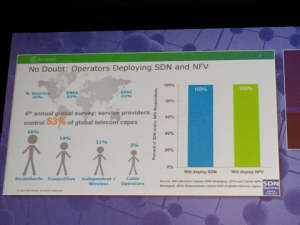
Running from 10-14 October in the World Forum in The Hague, Netherlands, Layer 123’s SDN World Congress brought together more than 1,600 industry experts. The event’s main message was simple: more industry players than ever are looking into NFV and SDN, and they are part of a tremendous journey that will change the industry fundamentally and forever.
It Always Comes Back to The Customer
Customer needs are changing rapidly, with a strong preference toward digital-first experiences. You can thank the influence of over-the-top (OTT) cloud service providers for that. Unsurprisingly, a lot of talk at the event was about delivering a superior customer experience through a more agile and elastic network environment. SDN and NFV are not goals to be achieved, but rather the means to service transformation to better the personal customer experience.
But, SDN and NFV are about more than technology evolution; they represent a paradigm shift that will change how future operators and businesses will work. Technology is a big part but people, processes and organisation are even bigger. The business case-led way of thinking and working is growing stale, as it’s unrealistic to build a “business case per network function” as we’ve learned in dusty old presentations about network management.
The Multivendor-Proof Network Eliminates Vendor Lock-In
We heard a lot about the idea of vendor interoperability, or what is described as building a multivendor-proof network. This characteristic is a must-have, since avoiding vendor lock-in is one of the biggest benefits of NFV and SDN technologies. These benefits exceed the traditional single-vendor network approach in every sense.
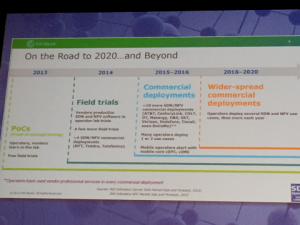 Of course, it won’t be easy to create a multivendor-proof network. It will require technology standardisation, cooperation, open source principles and set of defined interfaces: APIs. But it’s clearly the way the industry is headed, and the only way we will achieve the full benefits of virtualisation technology.
Of course, it won’t be easy to create a multivendor-proof network. It will require technology standardisation, cooperation, open source principles and set of defined interfaces: APIs. But it’s clearly the way the industry is headed, and the only way we will achieve the full benefits of virtualisation technology.
Standardisation Enables Multi-Party Cooperation
There was plenty of talk about the key role standardisation will play. Organisations like MEF Forum, Open Source MANO (OSM), the European Telecommunications Standards Institute (ETSI), OPEN-Orchestrator (OPEN-O) and the Open Networking Foundation (ONF) are leading the way. Comptel is involved in several of these groups, each of which focuses on its individual areas of expertise while encouraging collaboration, information sharing, discussion and debate. Ultimately, standardisation is advancing the multi-vendor and open-for-all approach to network design in acknowledgement of the desire for interoperability.
The nature of cooperative work within our industry is changing given this emphasis on multivendor networks. NFV and SDN are bringing companies together, leading to the creation of industry blueprints, proof of concept trials, and field experiments. Comptel is already involved in several, in fact.
The Network Automation Cycle
Many industry players at the event underlined the importance of automation and orchestration, driven by real-time analytics that rely on data and closed-loop processes to improve customer experience. They also advocated end-to-end seamless orchestration across new virtual and established services.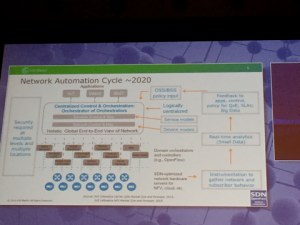
“Operations are the elephant in the room,” as one analyst aptly described significant operational concerns. Centralised and coordinated control and orchestration are the key assets that allow digital service lifecycle management in a hybrid network environment. The “orchestrator of the orchestrators” will be the enabler by providing a holistic, end-to-end view the dynamic digital services in multidomain networks.
There’s No Doubt: NFV/SDN Will Happen
NFV is going to happen; there’s no lack of confidence in the actual value of the technology. Of course it’s worth keeping in mind that it’s still early days for NFV, which remains an immature technology before standards become clear and stabilised.
The switch to virtualisation is both a technology and business challenge but even more it’s about culture, people, processes and trust. The true value of virtualisation comes back to the customer: you and me. At the end of the day, successful transformation will be about education, experimentation and strong relationships.
Network virtualisation will be a hot topic at Nexterday North 2016, which runs from 28-29 November in Helsinki. Register now to reserve your spot at the show.
]]>
The Nexterday Tour 2016 is our global effort to share the latest, most dominant and most appealing market trends directly with our customers and partners. At the same time, we discuss key thought leadership themes, including how Comptel’s software addresses market requirements in Nexterday.
We want to tap into the latest industry trends and insights from major global industry events, including our own Nexterday North event, which asks telcos to stop thinking about digital transformation and start executing. We package everything together with content and videos from operators, industry speakers and thought leaders, and go on tour to deliver them to telcos around the world.
What is the Nexterday Tour?
The program includes trends and insights gathered from a number of big events, stretching from the Comptel anti-seminar Nexterday North in Helsinki last November, and extending through Mobile World Congress in Barcelona, TM Forum Live! in Nice, the Big Communications Event in Austin, and a scattering of NFV/SDN events throughout Europe and the U.S. Our next stop will be in October for Dreamforce in San Francisco and the SDN and OpenFlow World Congress in The Hague.
It’s the third consecutive year we’ve run a global program. You might have known our previous tours by other names – “Barcelona in a Box” in 2014 and “Beyond the Event Horizon” last year. We visited more than 15 cities last year, meeting with 400 individual customers from 45 global operators.
So far, this year’s tour has taken us to South America, Europe and the Asia Pacific region, adding up to over 10 countries, over 15 cities, dozens of operator brands and hundreds of individual customers. And the tour finishes with our second annual Nexterday North from 28-29 November, 2016 in Helsinki.
Top Themes for 2016
Our focus in 2016 is on digital transformation and disruption within the telco industry.
We wanted to cover how new players in telco – including startups, but also non-telco players like Airbnb, Uber and Spotify – are shaking up the industry with innovative digital offerings that require operators to change their approach.
We’re also covering broader global trends. In his keynote speech at Nexterday North 2015, Kjell Nordstrom talked about urbanisation, describing how within the next 20 to 30 years, 80 percent of the world’s population and 90 percent of its economic value will be centralised in 600 megacities. On the tour, we’ve discussed what that means for telcos in the years ahead.
Similarly, we’ve heard frequently about the increasing value placed on customer experiences. A massive 89 percent of companies planned to compete on the basis of customer experience this year, according to Gartner. How has digitalisation influenced that trend, and – as keynote speaker Mike Walsh will discuss at Nexterday North 2016 – how does the increasing level of consumer familiarity with digital tools and services impact telco innovation?
We’ve discussed new telco business models, new network technologies and new service opportunities. We know that networks are embracing software in the era of NFV, data centres and cloud. We know that the Internet of Things (IoT) is a major opportunity, but that 99 percent of devices aren’t connected to the internet yet. At the same time, we know that up to four billion people on Earth also lack internet access. So what are operators and the whole industry doing to solve that challenge, alongside the others?
We’re also covering a number of challenges and opportunities in our industry, such as the need to find fresh new data monetisation strategies to take advantage of customers’ hunger for digital services. We also discuss the increased need for hyper personalisation in marketing, sales and service, and the need for telcos to re-engineer their service orchestration models to suit a more self-serve, conversational and automated service delivery lifecycle.
It’s been exciting to get out of the office, speak directly with customers and hear their ideas and thoughts on all of these concepts. Generally speaking, we’re seeing operators starting to broaden their mode of thinking. Ideas that would have once been considered too radical for telco are now being carefully considered, whether it’s ways to change how we work, new service opportunities to tap into, or new global trends that affect our business.
It’s important for telcos to continue the conversation and step away from the industry’s collective blindspot. With the Nexterday Tour 2016, Comptel is proud to play a part in helping operators have these important discussions.
Join us on the Nexterday Tour 2016 by registering for Nexterday North 2016, 28-29 November, in Helsinki. You can check out our fantastic speaker lineup here, which to date includes digital transformation visionary Mike Walsh, marketing guru David Meerman Scott, futurologist Dietmar Dahmen, operator speakers and many more.
]]>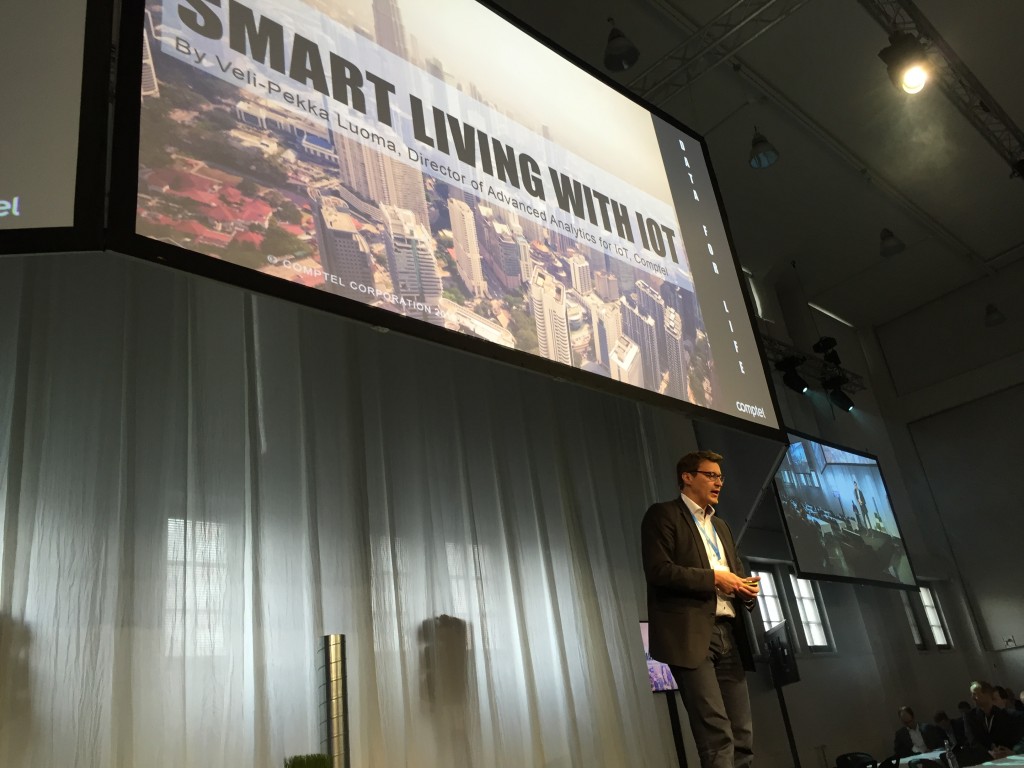
Veli-Pekka Luoma, Comptel
Although environmentalism was a major theme (event organisers used recycled wooden pallets as booth tables, for example), the event and the attendees were focused on different kind of environment: the holistic IoT ecosystem. There was one common denominator: Nearly everyone in attendance, across industries, was looking for technology partners to help them build or expand their own ecosystem of connected device solutions.
Comptel sponsored #IoTNordic and presented a speaking session with our Director of Advanced Analytics for IoT, Veli-Pekka Luoma, about the vital role data plays in the Smart Living movement. Comptel’s Intelligent Fast Data solutions offer businesses the power to sense, understand and act instantly on data “across the board.” Connected devices are another data source that produces aggregated information, alongside customer interactions, the network, social media, location and more. Businesses stand to benefit tremendously by pulling insights from all those different sources and applying insights to real-time actions. Those actions lead to better IoT-enabled experiences.
Industry can remotely monitor heavy machinery to run a “smart factory.” Health care providers can track personal data to offer intelligent preventative care, fleet managers can optimise routes for cargo vehicles, utility providers can provide efficient energy solutions with smart meters, and much more.
It all starts with smarter data. Through experimentation, partnership and solution co-creation, businesses – including operators – can apply data analytics to elevate the IoT beyond simple machine-to-machine communications toward humanistic benefits. #IoTNordic offered several compelling examples of businesses that are already succeeding in the IoT.
Elisa’s IoT Innovation Challenge
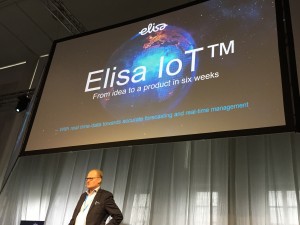
Elisa VP Markku Hollström
The Finnish operator Elisa has enjoyed many successes along its digital transformation. Its IoT service offering is one example. The company offers IoT connectivity, monitoring and analytics to a range of verticals, including a 3D real-time “Smart Factory” dashboard for industry, augmented reality solutions, and analytics-enriched monitoring and email notifications for the marine manufacturer Wärtsilä.
Elisa VP Markku Hollström explained that to succeed in the IoT, you need to experiment and develop a broad network of partners. That enables speed – the company profiled IoT projects that went from ideation to product in just six weeks. It’s also why the company is inviting businesses to participate in the Elisa Innovation Challenge, which will reward up to €85,000 in prizes to entrants who create innovative corporate and Smart Home IoT solutions.
Technology, Customer Experience the Focus for Tesla
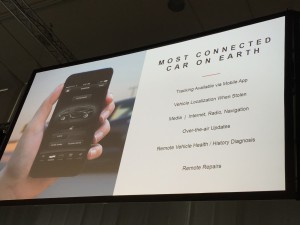
Tesla presentation at IoT Nordic
The electric car manufacturer Tesla says it is not in the business of selling luxury vehicles. At the show, the company’s speaker said the company’s focus is actually in transitioning the world toward safer, sustainable transportation. The IoT plays a big role in that: Tesla says its vehicles are the most connected cars on Earth, and their mission is to incorporate technology to create a software-based, analytics-informed driving experience. Even their car buying experience is innovative; it’s entirely online, making it a modern, customer-focused approach to purchasing.
Are Device Implants the Future of Health?
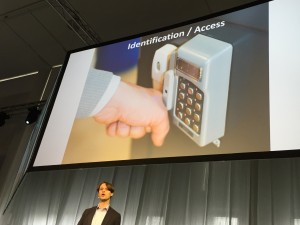
Hannes Sjöblad, BioNyfiken
Hannes Sjöblad of BioNyfiken presented a fascinating look at the role of NFC implants in human health, which his company says is humanity’s “personal key to the IoT”. This technology already exists – in fact, we saw a live demo at the end of his presentation of a human implant placed into a person’s hand. While also a bit scary, the demo did show the amazing potential of implanted devices to enable everyday individuals to “speak” to connected devices.
There are simple but very relevant use cases, like replacing keys, ID cards, tickets and boarding passes with implanted chips, and use cases that are more humanistic. Personalised chips could ensure a gun can’t be operated by an unauthorised user, for example, or even play a role in curing blindness, deafness and paralysis.
Securing the IoT
Of course, any conversation about the many uses cases for the IoT eventually falls back on security concerns. In his keynote speech, Mikko Hyppönen, Chief Research Officer of F-Secure explained that the IoT will only expand the number of threat vectors (how do you secure your Wi-Fi if it’s being shared by your refrigerator?), creating more opportunity for highly sophisticated cyber criminals and making it more difficult for consumers to maintain privacy.
The number and variety of IoT devices will make single-device protection impractical, said Hyppönen. F-Secure, for example, has no interest in developing anti-virus protection for your connected toaster. However, the company does develop full-home Wi-Fi security solutions to ensure every device on the network is secure. Furthermore, F-Secure compensates independent hackers who find holes in their security system, when many of those hackers may have otherwise sold that information to cyber criminals. It’s a good solution for F-Secure: Paying for hackers to find holes in your system is a clever and efficient way to find vulnerable spots in your environment.
As Hyppönen said, ”Web content is not free. It is paid for with your data. It’s paid for with your privacy. And it’s too late to change that. We have raised a whole new generation who are used to having content for ‘free’ on the web. And yet, we don’t understand what this means.”
That’s an important takeaway to keep in mind as businesses and operators tiptoe – or dive head-first – into the futuristic world of the IoT.
Learn more about the IoT opportunity for telco in a new whitepaper from Comptel and Heavy Reading. Download “Smart Cities & Smart Living: The Role of Telecom Operators.”
]]>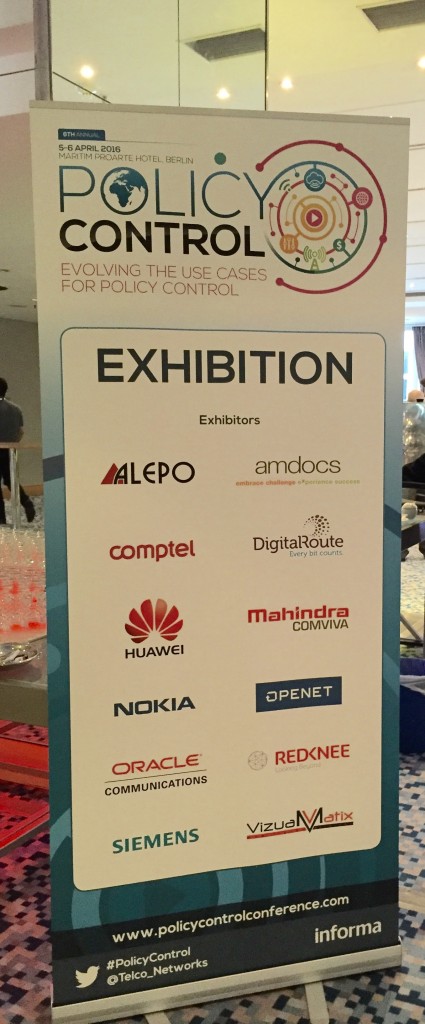 Policy control cannot be seen as a standalone function any longer. It needs to be combined with charging and predictive analytics to give customers the best, most contextual and personalised service experience. At the same time, effective policy and charging control also gives operators the flexible and agile tools they need to monetise data services. That was one big takeaway from the Policy Control Conference 2016, which bills itself as the world’s only event exclusively dedicated to the policy control market.
Policy control cannot be seen as a standalone function any longer. It needs to be combined with charging and predictive analytics to give customers the best, most contextual and personalised service experience. At the same time, effective policy and charging control also gives operators the flexible and agile tools they need to monetise data services. That was one big takeaway from the Policy Control Conference 2016, which bills itself as the world’s only event exclusively dedicated to the policy control market.
Nearly 200 policy control enthusiasts from 80 organisations gathered at Berlin’s Maritim proArte hotel from 5-6 April to learn about the latest and greatest developments in the field of policy control. The entire policy control ecosystem was represented, with scheduled presentations from solution vendors, operators and industry analysts. Executive speed networking, operator-hosted lunches, analyst breakfast roundtable briefings and operator and vendor dinner also offered plenty of opportunity for interaction.
Comptel was in attendance as a sponsor, and we also hosted “The Seven Deadly Sins of Policy Control,” a session with our VP MONETIZER Simo Isomäki and our VP Solution Architecture Martin Vieth. We highlighted the defective, broken aspects of policy control that needed to be corrected as operators evolve toward a modernised and future-proof policy environment. At the event, attendees heard how operators are addressing challenges like time to market, increasing customer experience demands and the introduction of virtualised functions into the network through innovation policy control management. Here are several big takeaways from the event.
Complexity Slows the Speed of Innovation
Network agility is crucial to delivering the flexibility operators need to achieve a higher speed of service creation, which is a valuable asset at a time when monetisation opportunities crop up at a moment’s notice. However, overly complex telco networks slow everything down, making it difficult or in some cases impossible for operators to configure and launch new services fast enough to attract customers at their peak moment of interest.
Simo and Martin explained that the blame lies with complex and scattered network architecture and management, which kills innovation. As a result, many operators are “dead slow” – 69 per cent of CSPs say launching a new product or changing a product takes too long, according to Heavy Reading. The right environment and toolset could speed things up by giving operators a single view to create and change products and allow for service creation experimentation. Operators should strive to innovate when it comes to service pricing, add-on apps, data bundle configuration, delivery speed and more to appeal to digitally savvy customers.
 NFV and Policy Control
NFV and Policy Control
Network functions virtualisation (NFV) is, naturally, one key area of innovation affecting policy control. PCRF is often one of the first network functions to be virtualised as operators seek to respond quickly to changing market conditions.
Many telcos in attendance acknowledged the benefits of NFV, including its ability to drive a 95 per cent improvement in service cycles, outweighed the potential challenges of implementation. Presenters argued that policy control and analytics should be tightly integrated with network and service orchestration, delivering service and customer awareness to the NFV and SDN network.
At the same time, the Comptel presentation emphasised simplicity above all in NFV implementations. Operators are striving towards NFV – one said “If you don’t do NFV, you’ll be left behind”. In our session, Simo and Martin advised a hybrid approach in which brand-new NFV infrastructure and legacy environments work in cooperation to maintain simplicity.
Analytics Enables Better Service Experience
Another major theme at the show involved the central role customer experience should play in policy and charging control management decisions. For example, moving away from the idea of standalone policy control and toward a vision for natively combined policy control, charging, predictive analytics and real-time business reporting helps operators deliver a better and more targeted end-to-end service experience.
One operator described how they currently analyse customer usage behaviour and patterns with a Big Data cognitive learning analytics platform. Using that data, they can guide their policy engine for example to offer the best service with the most attractive apps to customers. Predictive analytics also informs service testing, so that operators can test and affirm a new services’ success before launching it publicly.
 The Customer is at the Centre of Service Experience
The Customer is at the Centre of Service Experience
Forward-looking service creation puts the customer at the centre by selling services the way buyers want. As Fredrik Jungermann explained at Nexterday North 2015, customers buy data by the bundle today only because that’s the way operators choose to sell data, but that doesn’t mean it’s the only way or the perfect way to sell data. Rather than simply selling data on a small, medium, large or extra-large model, Simo and Martin advocated a model where data is flexibly bundled with attractive over-the-top (OTT) content services to appeal to the customer’s preference.
Additionally, there were discussions around the importance of offering consistent mobile service experience no matter the customer’s location. Presenters argued that there is value in policies being access-neutral whether a customer is on fixed internet, mobile data or a Wi-Fi network.
Similarly, operators could change the way the allocate bandwidth per application to improve service experience. Twitter and Netflix, for example, don’t need the same bandwidth speeds to run successfully, but that is currently how those apps are supported by many internet service providers. Why not flexibly support apps with an appropriate level of bandwidth, reserving the best speeds for live streaming videos?
Ultimately, that’s how operators and the industry need to think about policy control moving forward. The customer should always be at the centre of any major innovation in the network or otherwise, so an evolution in policy and charging control should likewise focus on improving the customer experience. Since complexity is the enemy of innovation, operators will need to only consider transformation that can make things work more simply and quickly.
Learn more about the tools how to monetise more in less time: Download our whitepaper about the MONETIZER™ or register to our MONETIZER™ webinar or click to read about our MONETIZER™. To keep up on the latest news and discussion topics, please join our Magazine and Reader Community in nexterday.org.
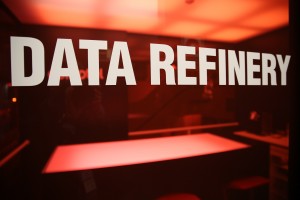
A consistent theme throughout MWC 2016 was the idea that operators are sitting on a store of customer data that, like an untapped oil reserve, could deliver rich insights that lead to significant revenue opportunities. Rising interest in the Internet of Things (IoT) isn’t making matters easier – we saw a flood of manufacturers demonstrating their latest connected devices, from cars to wearables, at MWC 2016, plus a fair share of big thinkers promoting their vision for larger-scale, IoT-enabled operations, like smart cities. Here are takeaways from the MWC panel “Operator Customer Analytics,” where those challenges and opportunities were discussed.
The Operator Perspective
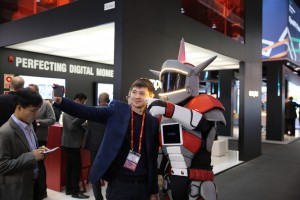 Operators have always collected data, but the ways in which they pool, interpret and act on information has changed as technology and processes evolve.
Operators have always collected data, but the ways in which they pool, interpret and act on information has changed as technology and processes evolve.
Kuan Moon Yuen, CEO of the consumer group at Singapore-based operator Singtel, explained that his company has developed a more sophisticated analytics estate by pooling insights from multiple data sources. Customer data usage has always been important to telcos, but Singtel stressed that analysing other information – location, device and real-time contextual metrics – allows operators to deliver tailored network optimization, better customer support and predictive, real-time marketing.
Dr. Jiwon Ashley Joo of SK Telecom agreed that context changes the way operators can serve customers. Her company changed its analytics framework to gain a more holistic view of how its customers interact with various services. This type of observation led to service innovation, including a popular new connected wearable device for kids and pets. As these new services are used, the operator collects even more information about its users, which inform future initiatives.
The Standards Association Perspective
 Of course, it’s easy enough to point out operators’ need to mine, interpret and act on their substantial data reserves. Rob Rich of TM Forum clarified the challenge by reminding MWC panel attendees of the significant skills gap that prevents many operators from actually putting these ideas into practice.
Of course, it’s easy enough to point out operators’ need to mine, interpret and act on their substantial data reserves. Rob Rich of TM Forum clarified the challenge by reminding MWC panel attendees of the significant skills gap that prevents many operators from actually putting these ideas into practice.
Of the substantial volume of data currently floating out there in operator environments, a small percentage – about 5 percent, said Rich – is actually actionable. To increase that percentage, operators need to develop an organizational culture for sharing data, and raise their level of sophistication when it comes to leveraging data.
That underscored what’s perhaps the biggest challenge operators face in maximizing customer data: they’re already a bit behind the eight-ball. For digital-born companies like Google and Facebook, a data-centric culture, mindset and competency is already built-in. Telcos need to change to acquire some of those qualities.
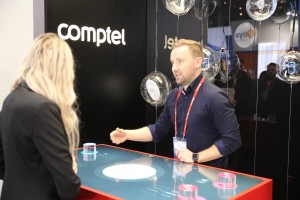 The Customer Engagement Automation Solution Perspective
The Customer Engagement Automation Solution Perspective
So, if the objectives are to combine multiple insights from disparate data sources, get smarter about how your organisation manages and analyses data and change the culture of your organisation to be more data-centric, what’s your next step?
Third-party partnerships can help operators improve their level of sophistication around analytics initiatives, even democratising analytics insight, so anyone from IT to marketing to sales can make smarter decisions about customer information. Analytics platforms bring together raw data from multiple sources, enrich it to provide context and drive the right actions instantaneously. These solutions enable automated and real-time decisions and actions, helping businesses keep pace with fast-changing buyer needs and wants.
The biggest opportunity here is in real-time and contextual marketing: an operator who learns a customer is running low on mobile data while that individual is listening to a streaming music app has the chance to deliver a highly relevant and compelling top-up offer at the perfect time. It’s how marketing can and should work if you’re able to act in real-time with the right information about your customer.
Learn more about how successful operators leverage customer analytics data in our new book, Nexterday Volume II.
]]>
First, it was very clear that the Internet of Things (IoT) will be a huge business opportunity for many companies, including operators. Cisco projects that the market for IoT services and technology could generate $19 trillion between 2013 and 2022, while more than 50 billion individual IoT-enabled devices will be connected by 2020.
Secondly, it’s clear we’re moving toward a digital society. Everyone is becoming digitized, and in fact, European operator Tele2 claims that in the IoT economy, all physical things will have a digital twin. And it’s that digital twin which creates digital dependency and product “stickiness” to customers.
What’s the best way forward for operators? How do telcos who have long been focused on connecting customers with traditional voice, messaging and enabling customers’ data access now pursue intriguing new opportunities in an emerging field? Various presenters, a handful of which were operators, at IoT World Forum offered their suggestions – here’s our recap concentrating mainly on the CSPs’ IoT strategies and takeaways.
Find a Good Monetisation Strategy
Ultimately, IoT is about data, and data analytics.
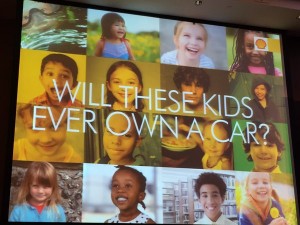 Naturally, operators want to know exactly how they turn all that data generated from those billions of new connected devices into revenue. It was stressed that connectivity is not the only way for operators to earn from IoT, in fact operators need to go beyond connectivity. So instead, telcos must take a service-led approach, relying on connected devices to offer the data that fuels highly personalised and relevant services to customers.
Naturally, operators want to know exactly how they turn all that data generated from those billions of new connected devices into revenue. It was stressed that connectivity is not the only way for operators to earn from IoT, in fact operators need to go beyond connectivity. So instead, telcos must take a service-led approach, relying on connected devices to offer the data that fuels highly personalised and relevant services to customers.
There was an interesting example of an auto insurance provider that defines customers’ insurance policies based on their driving behaviour, which is monitored and tracked by in-vehicle sensors. In this model, IoT-generated data is directly influencing how a consumer service is delivered and priced. Accompanying this behaviour-based insurance model there was a discussion about the other possible alternatives companies might price the IoT, including an ad-funded model, subscription-based model, consumption-based billing, and data trading.
With IoT, the market is moving from CAPEX to OPEX-driven business models, to a ”software as a service” or what one might even call an ”everything as a service” approach.
Find an Innovative Use Case
Operators showcased an amazingly big spectrum of innovative use cases in the field of IoT. These are stretching from various health apps and assisted living to home appliances, smart logistics, smart cities, connected cars and fleet management. Some operators have even made IoT a primary business focus, including one major Tier 1 operator that explained its concentration on the health vertical. To guarantee the best possible success in this domain, they’ve even hired medical doctors to consult on the digitalisation of healthcare.
Build an Ecosystem of IoT Partners
Nobody walks alone in an IoT-driven service ecosystem. IoT market is not be a “one-man show, but rather an ensemble piece.” No single player offers an end-to-end platform that serves a complete array of business use cases.
Bringing all this data together through a compelling ecosystem and service partners, creates a win-win situation for key IoT players. The proposal is to go forward with a culture of experimentation and multi-party models of joint-testing and trials that allow partners to establish proofs of concept and address difficulties before products are released to market, meanwhile applying the well-known principles of “fail fast or scale fast” and “think big, start small and scale fast.”
Address Changing Behaviours to Win Customers
What makes an IoT offering successful? What separates products that are simply hype from those that are genuinely compelling to customers? One conference presenters said “behaviour change is the killer app of IoT,” while another pointed out that the “user is at the centre of IoT.”
There was a common consensus around the popularity of wearable fitness technology. Customers love their FitBits and Jawbones mostly because these devices help their owners become more active. In this case, an IoT device is addressing specific customer behaviour – the desire to live a healthier lifestyle.
Similarly, David Bunch of Shell asked whether today’s youth – more of whom view cars as functional appliances rather than an aspirational purchase – cares much at all about owning their own vehicle. As a result of this changing behaviour, Bunch argues that it’s more a question of when, not if, connected autonomous vehicles will roam city streets as the preferred method of transportation.
Unlike discussions that position the IoT as a sort of futuristic piece of science fiction technology, the tenor of the conversation at IoT World Forum focused on real, pragmatic solutions. For operators, the way forward involves service-led business models and creativity pricing, the creation of beneficial partner ecosystems, establishing innovation labs and a priority on IoT-enabled services that serve evolving customer behaviours and desires.
Download our book, Operation Nexterday, to learn the strategies and solutions that help mobile operators innovate their service offerings and intrigue Generation Cloud consumers.
]]>
A number of business leaders, technology experts and futurists presented inspiring talks on their vision for the future of digitalisation, but three keynotes stood out most prominently. The first involved a view of the futuristic technologies businesses will require to push themselves forward, the second stressed the importance of pushing boundaries, and the third encouraged businesses to accept what they don’t know and focus on improving the post-digital buying experience, mirroring what Comptel has said on the topic of Operation Nexterday. Here’s our recap.
A Peek at IBM’s Post-Digital Cognitive Era
IBM has positioned itself as a frontrunner in the “cognitive era,” characterized by a new capability that the tech giant believes companies will need as they move further, and even beyond, the digital era. In his keynote, IBM’s Juha Teljo, who leads European sales for IBM’s business intelligence and predictive analytics technologies, described why cognitive abilities will be the next significant technology for forward-thinking companies.
Cognition, Teljo explains, will allow businesses to understand, reason and learn much in the same way that humans do. Rather than rely on static data for business decision-making, IBM believes the next generation of business intelligence will offer predictive, machine-learned insights through cognitive technology.
This echoes Comptel’s thoughts around operators’ need for intelligent fast data, which drives real-time, automated and contextual marketing, in-the-moment analysis and instant revenue opportunities. Given the speed at which consumers make decisions and demand results, cognition and machine-learning capabilities will be crucial tools moving forward.
Toroidion’s Pasi Pennanen on Pushing Boundaries
It takes imagination to create big ideas, but to accomplish them takes “the next level of courage,” as Pasi Pennanen’s Toroidion project shows.
One might say that Pennanen has plenty of both, and in his keynote he shared his truly fascinating story of how he applied imagination and courage to make his dream of an electric vehicle reality. Pennanen is the creator of the Toroidion 1MW concept car, an eye-popping 100 percent electric sports car with 1,341 horsepower – making it one of the most powerful cars of any type in world.
Pennanen explained how he dreamed of becoming an industrial designer for cars since he was a child – a perhaps atypical ambition for a Finnish youth, but nonetheless one he pursues to this day with the dogged belief that anything is possible. He originally designed the Toroidion to compete in the famous Le Mans 24-hour road race, but now says he envisions his cars eventually being mass produced for everyday consumers.
To achieve that goal, he and his company will need to overcome a great number of challenges and obstacles, but Pennanen is driven to push boundaries in product development and design. It’s a model any business – but especially operators faced with a rapidly evolving telco landscape – should follow.
Futurist Dietmar Dahmen on Accepting the Unknown, Loving the Unknown and Embracing the Unknown
Right now, most operators acknowledge that they are surrounded by a significant number of opportunities coming from all sides. Whether they want to re-engineer their infrastructure for better flexibility and agility through network functions virtualisation, enhance their analytics capabilities through machine-learning technology or design imaginative service plans at warp speed that pique consumers’ interest, there are no shortage of options to revolutionise one’s business.
The challenge is, many operators don’t know which opportunities are right for them or how to proceed. There’s plenty of uncertainty surrounding these decisions, but in his keynote at the event, futurist Dietmar Dahmen expressed why it is important for businesses to accept and even embrace the unknown. As he explained, change is what makes us strong, and though it may feel comfortable to stay within the status quo, businesses must understand that to be a superhero in their industry, they must feel good about breaking rules, thinking exponentially and acting on their potential.

“Without Data Your Business Will Die”
In the digital and cloud era we’re online and connected pretty much 24/7. Dieter Dahmen’s statement ‘We are our phone’ is spot-on to describe our behaviour. Life is truly a chain of digital moments, but businesses are not able to respond to the opportunity that customers’ passive and active digital footprints allow. More than ever, it’s critical to leverage personalization and contextuality to deliver the right content to customers in the right moment. Unfortunately most organizations fall short, as “only 1 percent of companies can use data to invidualise across the channels,” according to Dahmen.
The consumer buying process is the most transformative experience industries need to deal with in the future. Pace is at the heart of it: our new generation of customers are impatient, want options and don’t like to wait. Dietmar Dahmen described it by saying “speed displaces cost as the main driver for purchasing decisions,” which makes moving at the speed of the internet a “life and death matter” for operators. But it’s very clear that at telco speeds, operators will struggle to satisfy clientele.
That’s a message Comptel shares: to break out of the collective industry blind spot and leverage new avenues of growth and revenue, operators must overcome their fear of the unknown and embrace out-of-the-box thinking. It’s the only way forward in Nexterday.
Register to join hundreds of progressive thinkers, industry experts and innovative operators at Comptel’s inaugural Nexterday North, 9-10 November. By purchasing a 2×2 Front Pass, you get full access to both Nexterday North and the startup conference Slush.
]]>Veli-Matti Mattila, CEO of Finnish operator Elisa, recently cited M Room’s app as an example of how mobile and digital services are changing our everyday lives. As Mattila explained, digitalisation is a major change agent in global society and has the power to disrupt all industries.
Digitalisation will usher in an era of business transformation that will radically change how all businesses including telcos, in particular, operate. Elisa is a prime example – the company may have once been known as a traditional voice provider, but today, it would be more accurate to call it a digital and communications services provider.
Elisa offers its customers much more than simple connectivity. Its range of consumer services include an entertainment service for watching TV with cloud-based recording and content on demand, a wallet app for mobile payments and a book app for avid readers. On the business-to-business (B2B) end, Elisa offers video conference, customer interaction services and social media listening services, to name just a few.
Mattila helped engineer Elisa’s digital business transformation in his 12 years as CEO, and the results have been significant. The company’s initial six-month financial review showed that, despite a challenging economic climate, Elisa made its best-ever result from January to June 2015. The company also reported an expected growth in year-to-date revenue compared to the same time period in 2014.
 Mattila’s comments reinforce what Comptel has discussed in our book, Operation Nexterday: digitalisation is forcing telco business transformation, and this adoption and evolution is vital if operators are to best serve individual and business customers and grow their organisations. Here are three takeaways from Elisa’s journey that other operators should note.
Mattila’s comments reinforce what Comptel has discussed in our book, Operation Nexterday: digitalisation is forcing telco business transformation, and this adoption and evolution is vital if operators are to best serve individual and business customers and grow their organisations. Here are three takeaways from Elisa’s journey that other operators should note.
How Telco Can Disrupt in the Digitalisation Age
Consider how private car hire and ride-sharing service Uber has transformed public transportation internationally. Customers can simply queue up the app to find a nearby driver and conduct the entire transaction digitally, making for an easy and cashless ride.
As more industries embrace digital technology – from massive international conglomerates like Uber to the local coffee shop on your nearest street corner – operators will increasingly find an opportunity to add value.
They can enter markets they may never have thought possible, such as delivering over-the-top (OTT) content, social apps and now even books, as Elisa has done.
Operators should not discount cooperating with other players and building digital ecosystems to accomplish this. In the case of Elisa, the Finnish telco purchased capabilities from other organisations to establish an enablement platform upon which it could disrupt the market.
Embedding a Digital Culture at Every Level
Of course, making this change is not easy. Not every operator may have the vision to execute a broad digital business transformation. But, as Mattila explained, businesses do not need a Steve Jobs-type visionary at the top to push forward a digital service strategy. All you really need is firm direction, leadership, courage to change and a willingness to try new things.
Senior management should be in charge of digitalisation, Mattila recommended, and the sales, distribution and customer service functions need to buy in as well. Change may happen incrementally, but as long as they are watching the market, experimenting and pushing in the right direction to rewrite their playbooks, operators can transform successfully. Those that do not will die and perhaps result in new life.
Experiment Often, With a Focus on Speed
Above all, transforming into a digital business is a matter of trial and error. Not every new digital service offering or business idea will succeed, but as long as operators try new things quickly and ‘fail fast’, they will have the opportunity to quickly recover, learn from the results and react and ‘scale fast.’
Telco organisations should not fear failure, Mattila advised, because mistakes inform future successes. Maybe one opportunity will stick and truly catapult the business forward. The experimenting done and ideas that survive will ultimately make a major difference in operators’ successful transition to next-generation digital and communications service providers.
This blog post is based on Veli-Matti Mattila’s interview on the Confederation of Finnish Industries (EK) website and written up by Antti Blåfield.
]]>Without a doubt, two of the biggest opportunities of this ongoing and dramatic transformation involve the Internet of Things (IoT) and Network Function Virtualisation (NFV). Several speakers, dedicated streams, catalyst projects, key notes and exhibitions offered proof points to demonstrate that not only is this transformation on its way – in many cases, it’s already happening around us. Here are three major NFV and IoT takeaways from the show.
An Impending Surge in NFV Deployments

Credit: Volvo
Comptel has discussed at great length about the transformative impact of NFV deployments on telecommunications. As we wrote in our book, Operation Nexterday, operators who don’t adopt NFV to speed their service delivery and achieve greater agility and scalability could soon see their competitors pass them by.
It would appear many more are starting to realize this, and thus, prioritise NFV deployments in the immediate future. According to one survey that was conducted by Heavy Reading and presented at TM Forum Live!, 23 percent of operators expect to implement NFV commercially within their networks within the next year, while 44 percent expect to do so within the next two years.
In a presentation, Appledore Research Group estimated that as many as 250 ongoing NFV trials are occurring around the world, which includes multiple proofs of concept within a single operator’s network and around 25 early “live” NFV deployments. These deployments are already revealing benefits: Virtual E-CPE (customer premises equipment) rollouts, for example, lead to ten-fold improvements in OPEX savings, while Virtual RAN (radio access networks) rollouts offer a smaller footprint and reduced energy consumption. The Heavy Reading study, which surveyed mobile operators specifically, highlighted many benefits to NFV, with respondents saying it helped achieve scalability in their IMS core and offered value in the policy and charging control function and their evolved packet core.
The IoT Inflection Point
Similarly, there was much discussion around the IoT “inflection point” – as in, the point at which IoT implementations and projects begin to trend upward.
For example, Volvo CIO Klas Bendrik discussed how the car group is addressing consumers’ desire to stay connected at all times by developing interfaces that allow drivers to identify safety hazards, time-saving routes and fuel-saving driving behaviours. The company intends to test 100 self-driving automobiles on Swedish public roads in 2017, which will be the first opportunity members of the public will have to ride along in an autonomous car in normal traffic.
Elsewhere, BT Group Director of Research and Technology Chris Bilton discussed an IoT project in Milton Keynes, England, in which BT Group was able to support the development of a citywide parking optimisation initiative that could be the first step of a full “smart city” project. The global market for Smart Cities is expected to be valued at $400 billion by 2020. The Milton Keynes project will be underpinned by a “Smart Data Hub” that will collect anonymous city data about factors such as energy, water and transportation, to let the partners and developers to address city challenges and innovate on new developments and solutions.
Urban planning, energy management, health care – these are all areas in which IoT is already making a difference, and naturally, operators are getting involved. As we discussed in Operation Nexterday, Telefónica uses machine-to-machine (M2M) connectivity to enable IoT services in the Tesla Model S in Europe, and separately manages a smart energy meter project that comprises 53 million devices across Great Britain. The company also relies on sensors to offer fleet management solutions to ensure trucks stay on course, meet delivery objectives and manage fuel efficiently. Tomorrow’s fleets of trucks could, then, look quite futuristic, covered in sensors that support various measurements and actions. These systems rely on M2M technology that is already within operators’ grasp and ready to be leveraged.
Partnerships Key to Accelerating IoT Innovation
 The IoT opportunity is huge. Cisco estimates the industry could be valued at $19 trillion by 2024. If IoT disruption is already upon us, how do we accelerate its growth?
The IoT opportunity is huge. Cisco estimates the industry could be valued at $19 trillion by 2024. If IoT disruption is already upon us, how do we accelerate its growth?
One key will be the establishment of new partnerships to unlock an open playing field for faster innovation. Mari-Noëlle Jégo-Laveissière, executive vice president of innovation, marketing and technologies at Orange, explained in TMForum Live! the need for telcos to build a partner ecosystem that extends beyond the usual suspects. Today telcos, she explained, are partnering with companies who they do not normally talk to and who are not like them. Examples include automobile manufacturers, pharmaceutical providers and IoT developers. On top of that, open APIs and platforms will allow developers to innovate faster, bringing new IoT solutions to market at a rapid pace.
Comptel has often advocated for the benefit of non-intuitive telco partnerships, specifically agreements between mobile operators and over-the-top (OTT) content providers to deliver new content-driven mobile data packages. Similarly, such out-of-the-box thinking could enable savvy operators to identify new service opportunities in IoT.
Want to learn more about the ongoing telco digital transformation? Contact Comptel Marketing ([email protected]) to find out when our Beyond the Event Horizon roadshow is coming to your city.
And join us in November for Nexterday North, our can’t-miss antiseminar where we will take a non-traditional, bold look by leveraging the concept of Thinking Ahead (looking at other industries to examine our collective blindspot), Thinking Again (re-examining industry learnings to challenge the status quo) and Thinking Beyond (learning from emerging startups who are disrupting the digital world).
]]>
